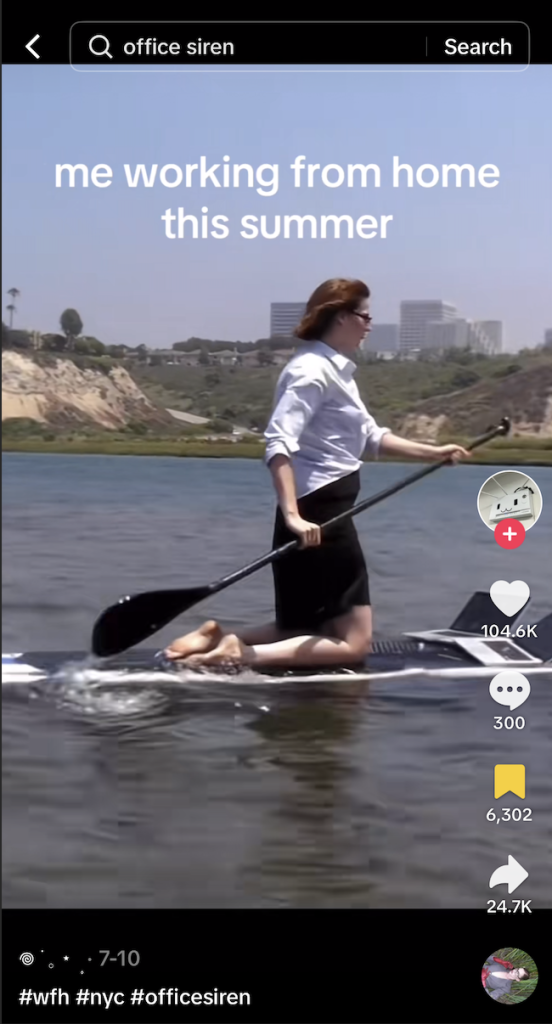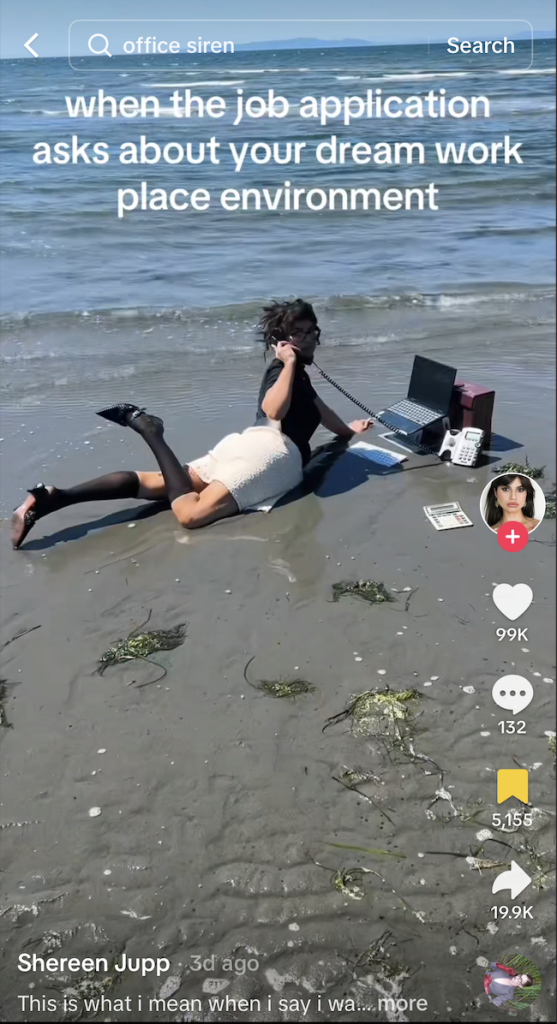Summer came and went. I realised I had spent just as much time being outside as I did watching others be outside. On TikTok, I came across clips of people drinking and relaxing on beaches (screenshotted outfits that were particularly linen-heavy), hiking next to sprawling lakes (saved to my “places” folder), making colourful drinks, etc. This is all seasonal, standard, maybe predictable. But then spotted another genre, one much more surprising and enigmatic: working on laptops and taking calls in the sea.
I was immediately drawn to these visuals of seemingly self-aware and slightly unhinged performances of office diligence, set outdoors to the soft tunes of Kate Bush or Enigma’s “Sadeness” track. It made me think of feminist performance art from the 80s and 90s, but from there I started to wonder what else these clips can tell me about not just the microtrend bubbles but online and offline spaces beyond my For You page. Following writer Marlowe Granados: 'as TikTok rapidly proliferates, its aesthetic influence [...] can be seen beyond the platform;' my goal is to theorise with these videos and images to extract ideas about not just online trends, but also gender performativity, corporate culture, and even environmentalism. To do this, first we must consider the following: who is this figure of the office siren, and what on Earth is she doing?
The Office Siren Emerges
It is not easy to pinpoint which user first started posting this kind of content. Bigger creators always have an easier time claiming that fame. Regardless, Tati Brueing, Gabriela Mendez, and Mimi Aarons all showed up on my feed around the same time over the summer, sharing their version of what commenters identify as the notorious 'office siren' aesthetic. Here, it is taken to the next level, as the creators descend into the water, evoking a mythological quality.
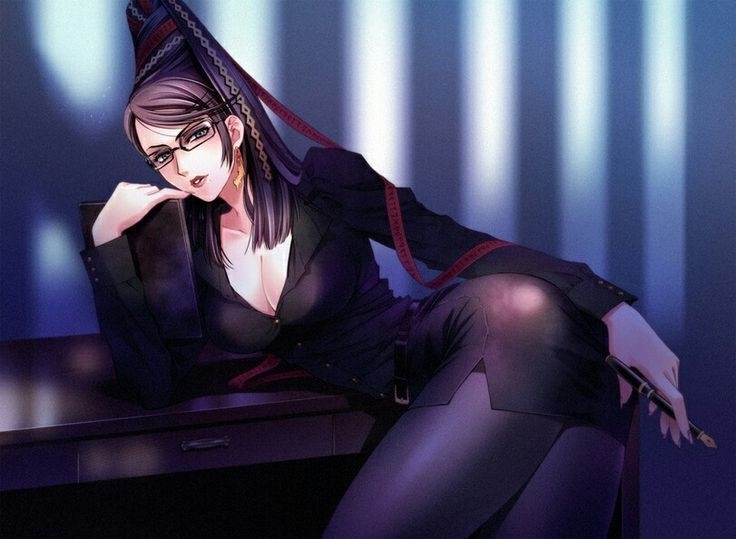
Bayonetta office siren fan art, https://primordiagamers.com/gallery/image/29058-bayonetta-office-siren-%F0%9F%98%B3%F0%9F%98%8D/.
When I search for the videos again, they are difficult to find as they often get posted without any hashtags or descriptions. Once I decide to follow the suggested 'office siren' term – which itself seems to have gained popularity at the start of 2024 – I first find fashion and beauty tips on how to achieve the look of a sexy and confident female office worker reminiscent of 1990s and 2000s popular films and fashion magazines. The video game character Bayonetta often shows up as a reference, with her signature black-framed glasses, long dark hair. Characters from films like The Devil Wears Prada (2006) and Charlie’s Angels (2000) also make an appearance.
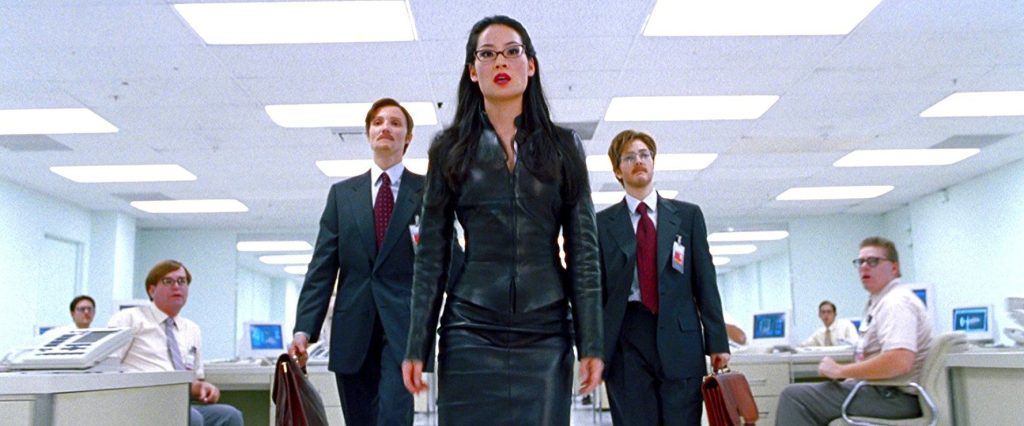
Still from Charlie’s Angels (2000) with Lucy Liu in the centre, dir. Joseph McGinty Nichol

Still from The Devil Wears Prada (2006) dir. David Frankel
One text-post from TikTok describes the style as: 'sleek, feminine, professional'; 'Samantha Jones from Sex and the City,' 'feminine, sexy, and successful without caring if she’s being judged.' If this is an evolution of the girl boss, I don’t particularly want it. I hope we are not mutating trends just to make our way back to romanticising being a worker under late-stage capitalism. But if we are, is this what we need to feel better about the state of the world?
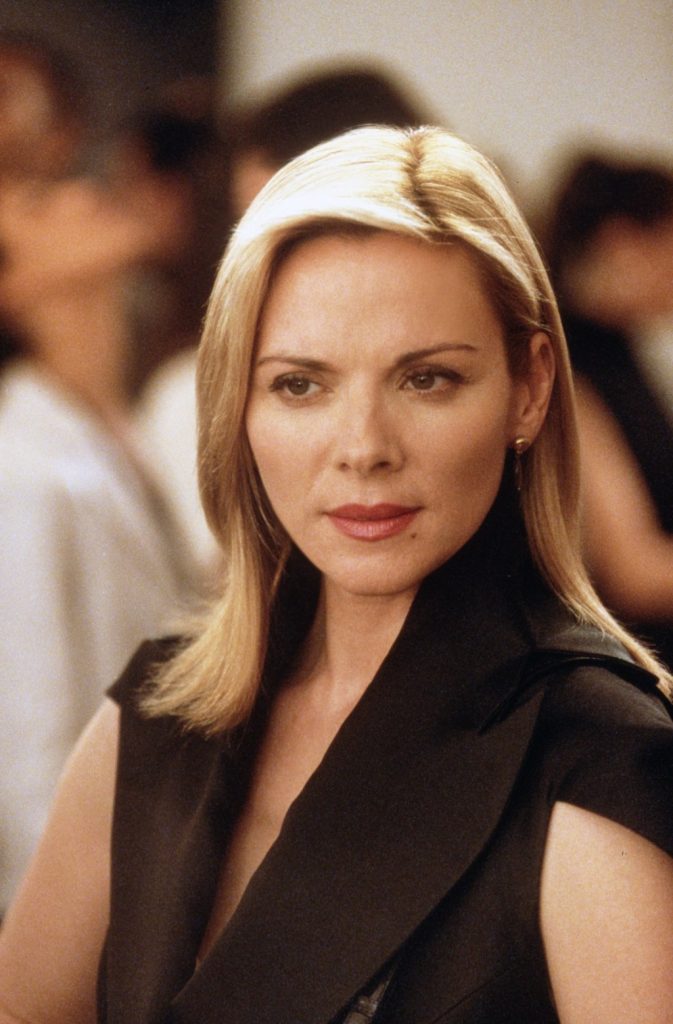
Adding to this discourse, another creator shares her verdict: 'to me, it’s like a costume of what people who don’t work think what it’s like to work [in an office]. I know it’s supposed to be vintage, work, recession, but it looks silly to me sometimes.' I look at the style tips: smokey 90s (I think?) eye make-up, lip liners and lip gloss, thin, black-rimmed glasses, sleek hair, playing with 'office-appropriate' patterns and materials but maybe showing more skin, subverting office-wear expectations, or bending various rules of what is 'office-appropriate.' The playfulness of the office siren aesthetic becomes clear. I am watching people online playing dress-up, in a way that seems more aware of itself and its purposeful shallowness than many preceding TikTok fashion trends.
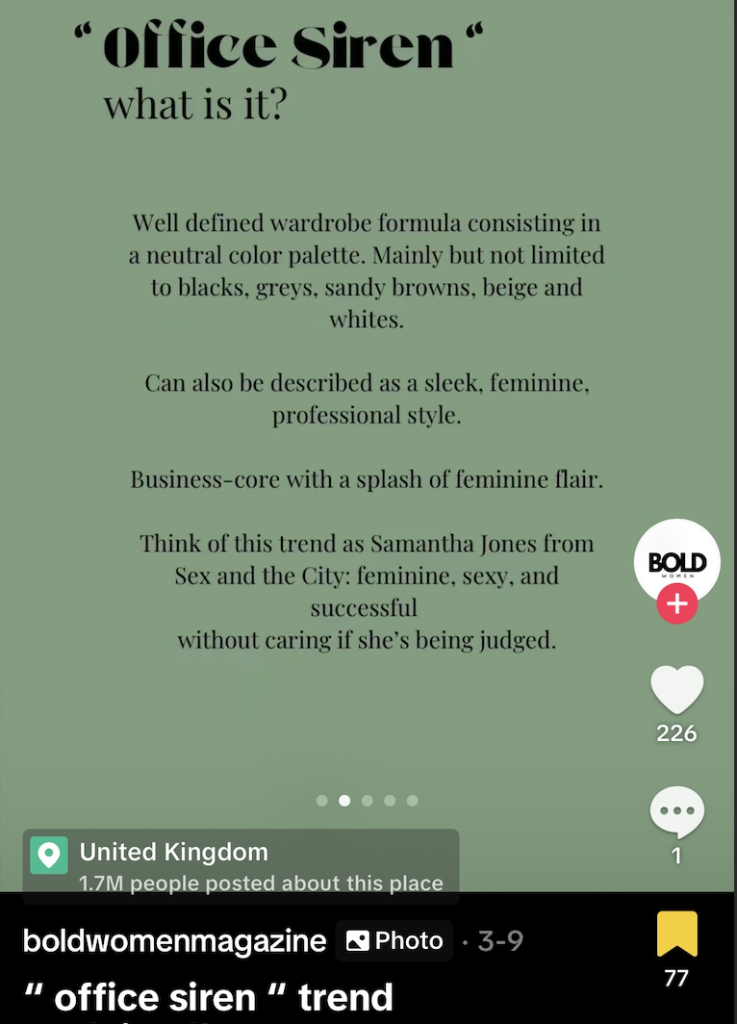

It could be that the office siren is an evolution of corpcore, normcore’s 9-to-5 sibling. Yes, we are commodifying every aspect of our lives by labelling ourselves ceaselessly and linking each label to a list of products to buy. It’s almost as though this is the only agency we have: when work is inescapable, permanent, when it bleeds into the rest of our lives, is it actually a rebellious act to narrow it down to its appearance – its signifiers – and choose to play with them, making the work unserious?
The office siren aesthetic stirs up conversations around authenticity – these people don’t even work in an office! – and femininity in the workplace, with HR workers 'reviewing' office siren posts to share whether they would get in trouble. We can’t seem to stop working, even when we go home. HR officers get on the good lord’s internet to continue policing appearance.
The politics of the office siren look are interesting as they ask us what categories we are expected to apply when thinking about 'professional' appearance, and how much of it is rooted in discriminatory and objectifying convictions. Are office sirens objectifying themselves by wearing stockings and low-cut blouses? Or are they reclaiming their version of femininity in male-dominated office environments? Does it really matter, since this trend seems to sit on TikTok first – with its playfulness and performativity – and in physical workplaces second, if at all?
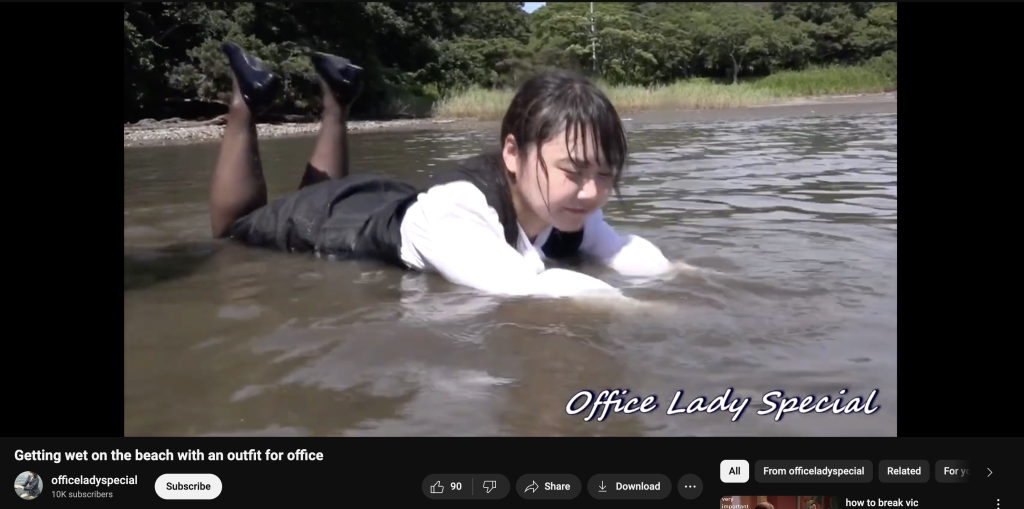
An example of officeladyspecial content, predating the office siren trend by many years.
One creator cites 'officeladyspecial,' a YouTube channel for a Japanese fetish website, as a source of inspiration. I watch their videos to see women in office wear walking on the shore, struggling against waves, drenched and confused. Maybe this content does pander to some kind of patriarchal desire of helplessness, but then again, it is self-proclaimed fetish content, unlike the videos I stumbled upon on my For You Page. It seems that the TikTok users’ references to pop culture point in the direction of empowerment instead of subjugation but the line is sometimes thin, as was the case with the aesthetics of cottagecore a few years back (I wrote a piece about that a few years ago).

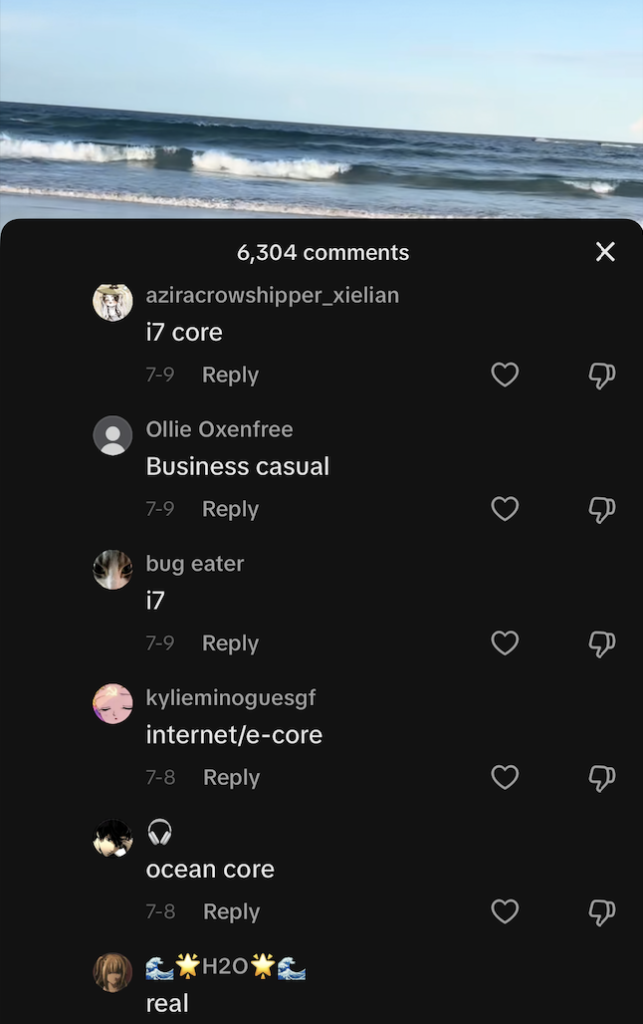
Some answers to 'what is this aesthetic called?' in the comments under a video.
So far, we considered what the 'original' office siren trend consisted of, and reflected on some of its characteristics and potential avenues of interpretation. It could be the case that just like with many other aesthetic trends online, the office siren also mutated into something more, something different – oceanic, watery, performative, fluid and always shifting. Perhaps the hot weather of the summer months in the northern hemisphere pushed her in the direction of the beach, where she can work remotely into infinity. Why is this link to water so strong, even identified by one user as “ocean core”?
Being Mythical / A Mythical Being
Women and water have a lot of history, often existing together in various mythologies and collective imaginations. The term 'office siren' points us towards the Ancient Greek feminine part-animal figure (bird or fish) who lures sailors to their deaths with their beauty and hypnotising power.
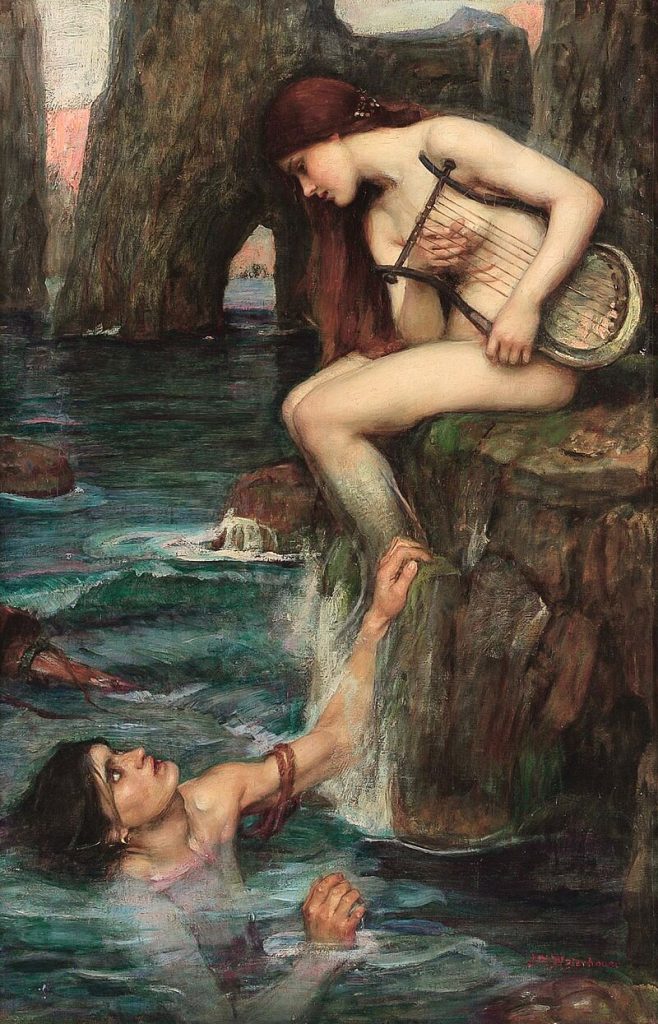
John Waterhouse, The Siren, 1900.
Then we have sea nymphs, Nereids, much less threatening than sirens and therefore easier to depict as docile in subsequent depictions throughout centuries. All over the world, Suvannamaccha, nure-onna, drowned girls and mermaids, spirits and messengers haunt the collective imagination of watery women and femmes.
The TikToks I am focusing on in this text are sirens reimagined: working girls, icons of remote work, patron saints of Teams, harbingers of corporate culture. To take calls from the shore is absurd, to pretend to work on your laptop as it drowns in seawater is tongue-in-cheek. These creators are performing productivity, just like so many others on TikTok who carefully prepare and share their morning and evening routines, exemplified by the ‘my 5 to 9 after my 9 to 5’ trend. But with office sirens, we have an acknowledgment of the silliness this kind of content shows – yes, I am recording my work, which means I had to set up this shot, so I might as well work on a laptop that is not working. Typing into oblivion looking at a black screen.
If we consider my office sirens as sirens in the mythological sense, they are symbols of hybridity. Not just 'part-human, part-animal,' but also 'part-online, and part-in-person.' Hybridity as flexible work, part-remote work that these creators choose to conduct outside, in seas and oceans, rivers and creeks.

Bartolomeo Guliano, Le Villi, 1906.
Hybridity, as in, you cannot escape your boss because they can see you through your webcam, and you are in your bedroom, working next to your bed, or maybe on your bed, and you can no longer cut your work out of your personal life, because your work is your life, your workspace is your leisure space, and you have no choice in the matter (if you don’t work, you die), so you should at least choose to be happy.
The siren laughs. She takes her company laptop and drowns it. She performs the endless cycle of desk job tasks into absurdity. Underwater, the tools of her labour short-circuit and become obsolete. Here lies her monstrous nature, and in this rebellion, she does what the rest of us are too afraid to do: she gets closer to logging off. Still, she is stuck in the rituals of corporate work, an officeid, or an Outlookoë. This tension is interesting to me. As if the watery language of capital keeps the office siren bound to her oceanic desk.
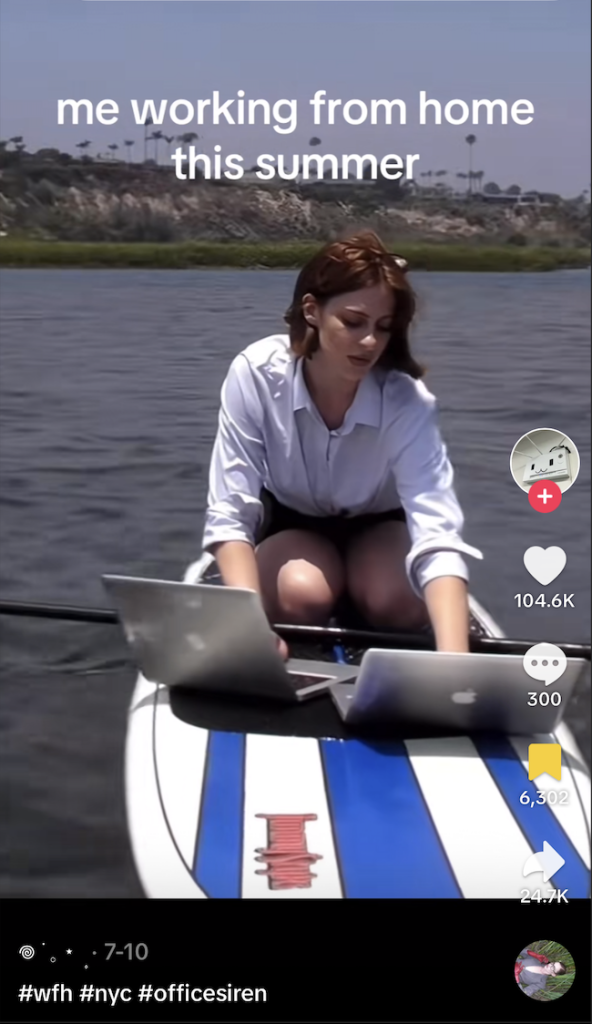

Disrupting the Flow of Capital
The relationship between this watery office siren aesthetic and remote work is something the creators themselves reference, adding captions or in-video text that echo the language of working from home.
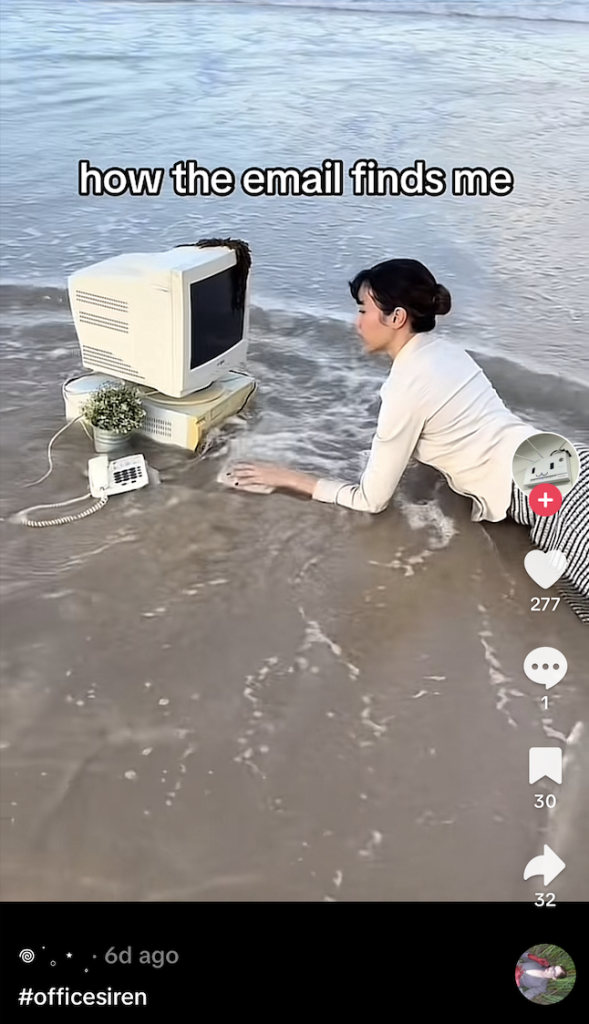
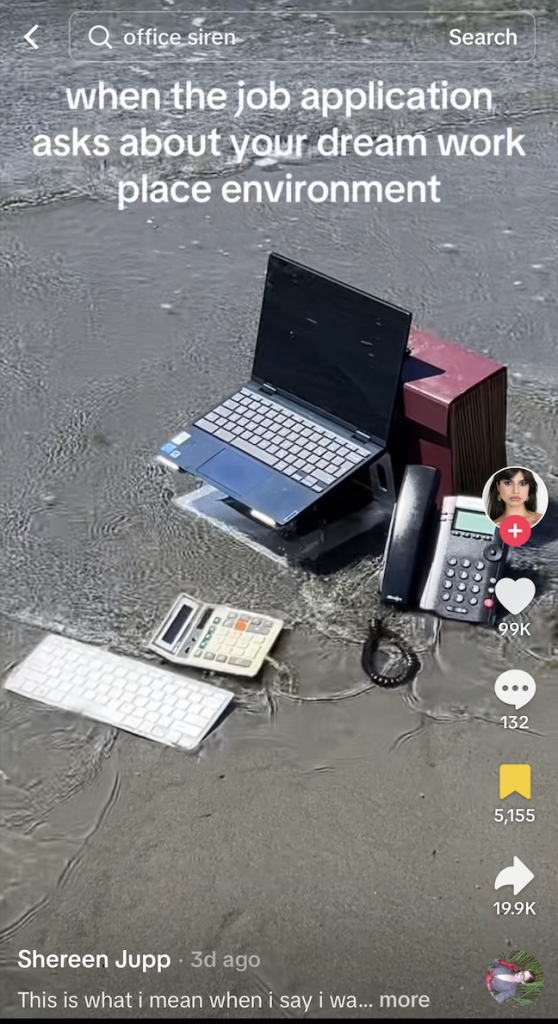
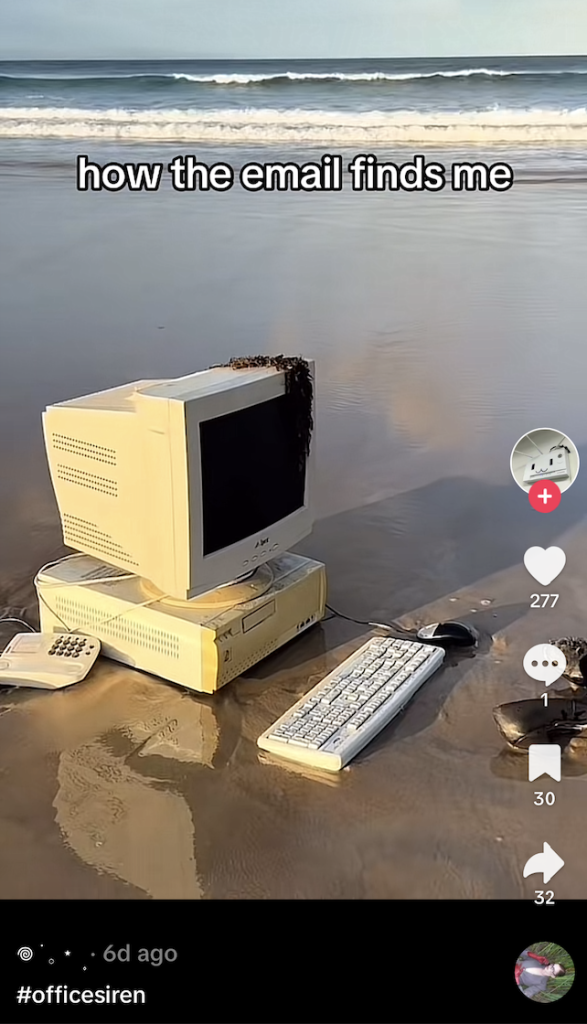
Could it be that these creators, instead of working against corporate culture, are working within its confines to see what is possible, what kinds of boundaries they can push? I base this on memes that keep emerging over the years about high-paying senior members of staff taking calls from the most random places, as though it is not jarring or unexpected. Ceara O’Sullivan’s character Lorraine encapsulates this well in the “millennial vs. their boomer boss” series. Younger workers are often not given the same level of flexibility as senior members of staff, bound by the expectation that you have to prove yourself, be on your best behaviour, embody professionalism in order to earn perks later down the line.

Andrea Fraser, Museum Highlights: Gallery Talk, 1989.
Writer Joshua Citarella claims that younger TikTok users are 'mocking a society in which self-determination and upward mobility have long since collapsed.' So, if young people are indeed disillusioned with work culture as previous generations have known it, maybe they can find joy in imagining and enacting the ability to work absurdly. Why not take the edge off of the kind of work that need not be serious?
Satirising corporate culture could be a way to break out of the confines that tell us to tie our dreams and aspirations to professional development. Especially in the wake of financial crises, political upheaval, and looming climate crises in all their manifestations, the dire need of a senior colleague to check in on your workflow and progress on a random weekday afternoon feels completely unnecessary and inconsequential.
This critique of ‘business as usual’ reminds me of second-wave institutional critique and works like Andrea Fraser’s “Museum Highlights: Gallery Talk.” As her alter-ego Jane Castleton – a visiting lecturer at the Philadelphia Museum of Art – Fraser takes visitors through the space, going through the motions and mannerisms of museum tours and sprinkling into the script jabs at the uncritical coloniality of North American (and European) museums, the exclusivity of donorship, and the increasing consumerism of institutions supposedly non-profit and in service of the public. Similarly, office sirens reach for the look of a diligent office worker and refuse to follow through, rebelling against the expectations of their ‘institution’ – their employer, presumably a for-profit corporation. This refusal to follow through sheds light on the modes of control built into seemingly neutral aesthetic and linguistic expected ways of being under late-stage capitalism.
We are all human beings with complex inner lives that corporate work, or any kind of work, can never satiate. A lot of young people online are realising it and talking about seeking fulfilment elsewhere, settling for 'easy' jobs or ‘quiet-quitting.’ The pandemic played a significant role in this shift, highlighting the inconsequentiality of much of the labour that goes on in the West under late-stage capitalism.
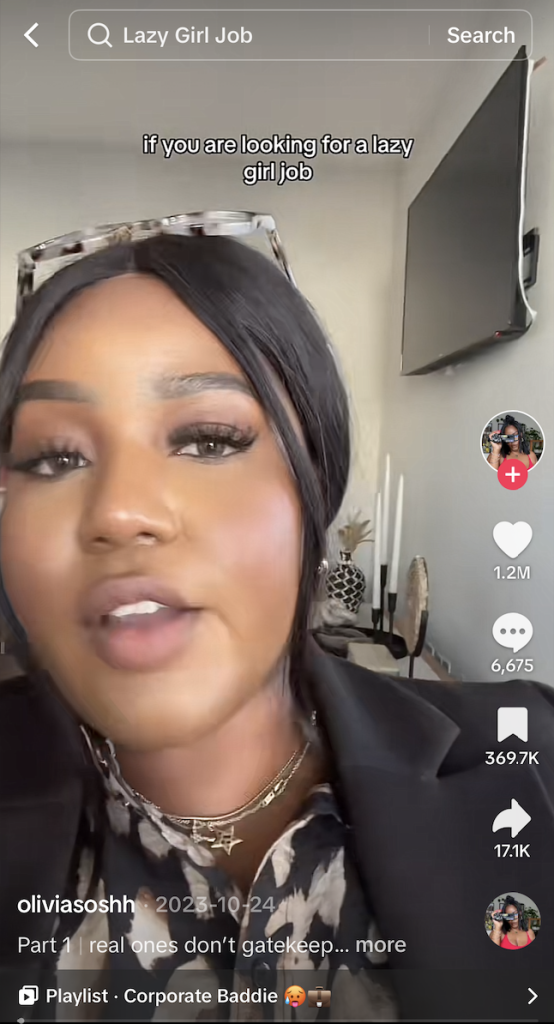
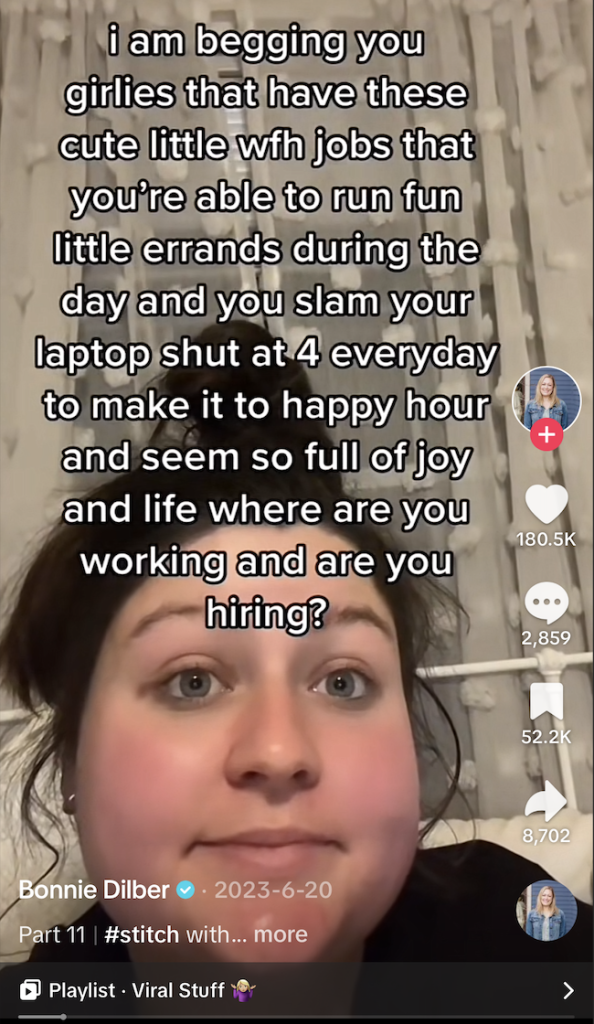
My office sirens chime in, typing away as their keys splash with seawater. I think this genre of videos emerged this summer partially due to this relatively recent push online to foster and protect our identities outside of work. If we go into the office to clock in and out, then its culture and conventions might start to look more and more constructed, therefore collapsable, malleable, material to manipulate and shape.
This kind of play could be one method to take back some of the time and energy that corporate structures steal from workers. To pretend to work, to record yourself doing it; to post it and maybe make money from that instead, or just make it to express something, read comments, start some kind of conversation, however fleeting. Maybe it is possible to disrupt the flow of capital through this kind of ambivalent anti-corporate performance.

Cindy Sherman, Untitled Film Still #8, 1978: becoming a beach girl!

Cindy Sherman, Untitled Film Still #59, 1980: Satchel in hand: traveling for work or pleasure?
There is power in putting on a mask. You get glimpses of what life could be like if you were someone else, if you looked different, thought different. An array of artists – I am thinking here of Adrian Piper and Cindy Sherman – dawn various personas, exploring new perspectives on how the world perceives them, how they perceive themselves depending on how they choose to present, what they choose to centre in their bodies of work. With Sherman’s famous untitled film stills series, it is exciting for viewers to decipher more-or-less cohesive identities for each character she presents, albeit while filling in blanks, but being able to use all the visual cues and references to popular culture the artist is leaving behind.
Meanwhile, my office sirens remain somewhat unknowable outside of their work identity. They put on vaguely vintage yet untraceable costumes and work on presumably broken equipment, which also reads as not 2024, but not specifically another date either. Their content critiques contemporary corporate obsessions with productivity, business, perceived success, but does not propose alternative ways of being beyond labour. Still, by uprooting a corporate aesthetic and making it absurd, they highlight the ruthlessness and pointlessness of business-as-usual, and this kind of disruption can resonate far and wide, like ripples on the surface of a lake.
Drowning in Emails, or Just Drowning?
Finally, I wonder if my siren is an environmentalist. Does she despair at the thought of rising water levels? The determination of these (pretend) office workers to keep typing as their laptop hits the water makes me think of Tweets and memes about how young people today will probably have to keep working forever. So, the ocean-bound office siren might also embody a fear of working until we run out of breath, or a related but more ephemeral existential anxiety or dread.


There is the obvious contrast between the laptops, phones, printers in these clips and the more 'natural' surroundings. Most of us probably don’t associate beaches with work: in fact, it is an image that comes to mind when you think of a holiday (how much this is influenced by travel agencies and capitalist definitions of 'relaxation,' I dare not think).
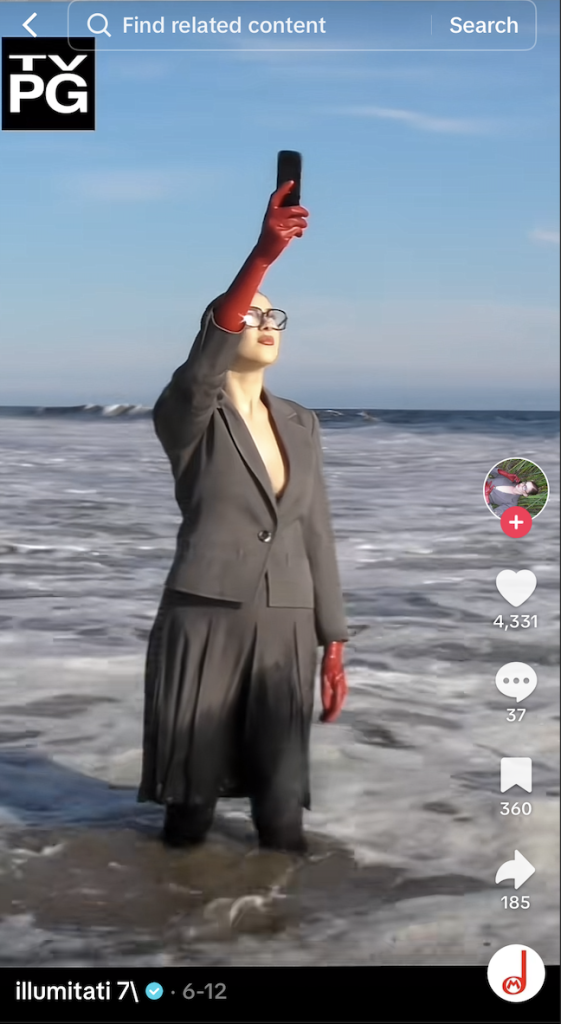
Yet, in an era of constant availability, you might find yourself taking calls from places that in the past made you think of leisure. In a sense, nothing is sacred. Work can happen anywhere, holidays are only this sought-after and carbon-heavy because of extreme expectations over how much we should work, and even bodies of water cannot escape the residue of microplastics and bits of office equipment as my office sirens dip them in, protesting the very thing they must do to survive – work.
This tension is what draws many users to these clips. It’s unexpected, even unhinged, to see our precious laptops reduced to malfunctioning props. The videos are often left to interpretation –posted without much of a description – which pushes users to ponder meaning and comment with compliments like 'this is art' (lured by the siren?). Indeed, it might be art. It definitely enters into conversation with a rich history of femme artists wearing personas and/or communing with nature, sometimes both. Ana Mendieta’s silhouettes come to mind, ephemeral and haunting.

Ana Mendieta, from Untitled: Silueta series, 1970s.
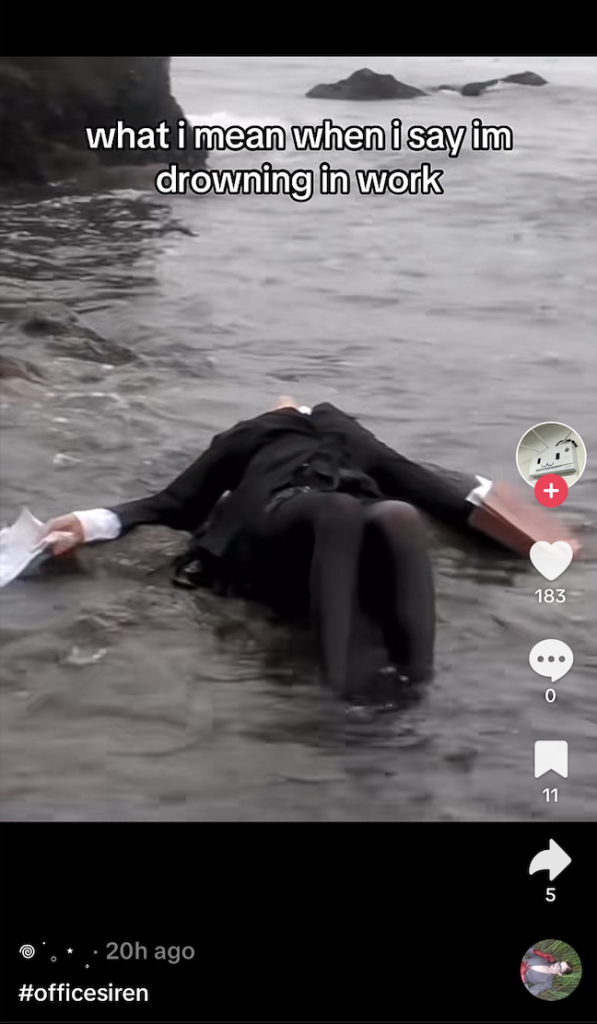
Media and theory scholar Martina Leeker comments: 'Art – specifically performance art – has traditionally prevailed as a method of gaining the distance necessary for a reflection and critique of techno-cultural conditions.' So, these clips can be read as a collective performance of the inability to break out of capitalist expectations. And in their mockery of corporate mannerisms, they propose an emerging aesthetic of refusal.
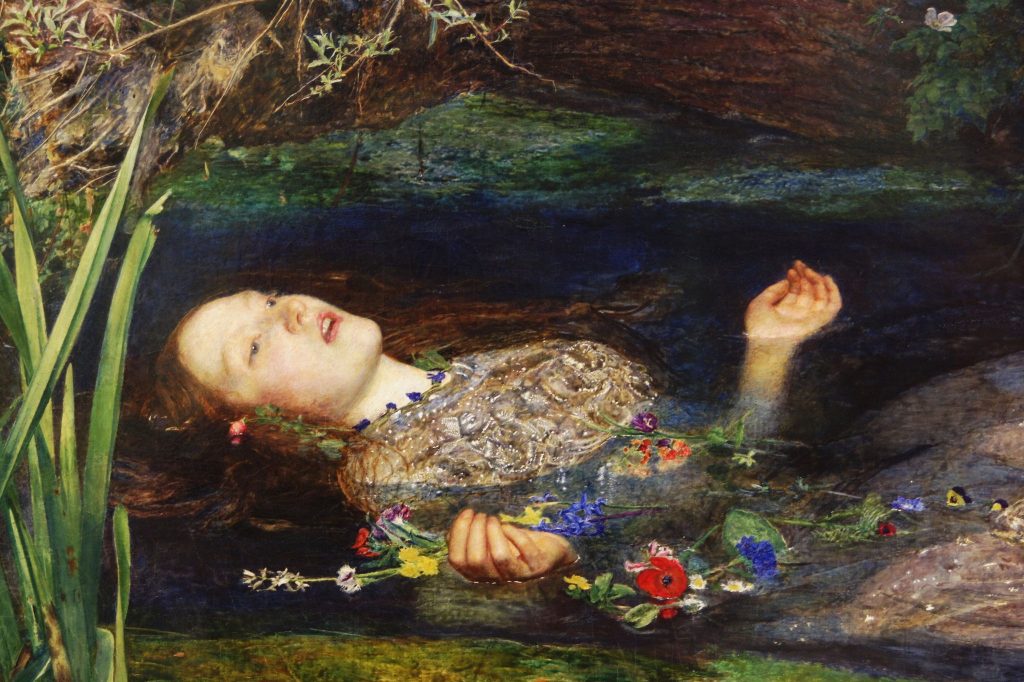
John Everett Millais, Ophelia, 1852.
Interestingly, one of the most popularised synonyms of the climate crisis is the rise of sea levels. As hybrid creatures working in a hybrid way, my sirens bear the brunt of changing environments by having to work partially underwater. Through them, we might also watch ourselves transformed, hybrid beings emerging from foam, especially through TikTok as a recent study by Jian Lin, Joëlle Swart and Guohua Zeng argued that 'the boundaries and distinctions between users’ identities become less clear-cut and subject to constant modulation.' In light of all this, who and what might we become?
Plastic is in our blood and our brains. We find it virtually everywhere we go. There is something monstrous in this kind of pollution, but monstrosity doesn’t have to mean a denial of humanity. It will be imperative to consider what kind of work is worth doing in these conditions, especially as they gain severity. Can we embrace monstrosity and hybridity – all siren-like, mythical, spanning across history – while making space for playfulness, joy, resistance, performance? Contemporary art scholar Anne Gerlieb suggests that 'TikTok favours playfulness over certain styles and looks.' If the mode of being on the platform is playfulness instead of striving for cohesiveness (often associated with early 2010s Instagram), then it is porous, and therefore more capable of moving through aesthetics and into another more relational way of being.
Where to Swim from Here?
My office siren takes on the behemoths of remote work and climate anxiety, working through them as she herself works. Through her eyes, we start to conceive of these notions differently. Through her submergence, we begin to see ourselves as more fluid, therefore more capable of facing various iterations of the future.
Trends on TikTok tend to move fast, transforming into new versions of themselves, merging into umbrella terms for similar sensibilities, or splitting into smaller sub-genres and trends. The girlboss phenomenon observed in the previous decade across platforms like Instagram and Pinterest might be rearing its head this year in the formulation of the TikTok office siren – a corporate girl seemingly content with her occupation, inspiring others to achieve the same. But the office siren in the sea knows she is being looked at. She puts on an absurd show that rejects normativity the girlboss strives for. In contrast to previous microtrends and aesthetic-specific online communities, the office siren performs in manners and settings that point to her self-reflexivity.
When considering previous outdoorsy aesthetics, VSCO girls come to mind. VSCO girls appeared online last decade, evoking a brand-friendly environmentalism and an appreciation for scrunchies, reusable water bottles, and a beachy life. Similarly, cottagecore users on TikTok and elsewhere filmed themselves in nature earnestly, walking through meadows and towards Victorian cottages on my feed as though to say: I do this all the time anyway, I just decided to film it for you just this once.
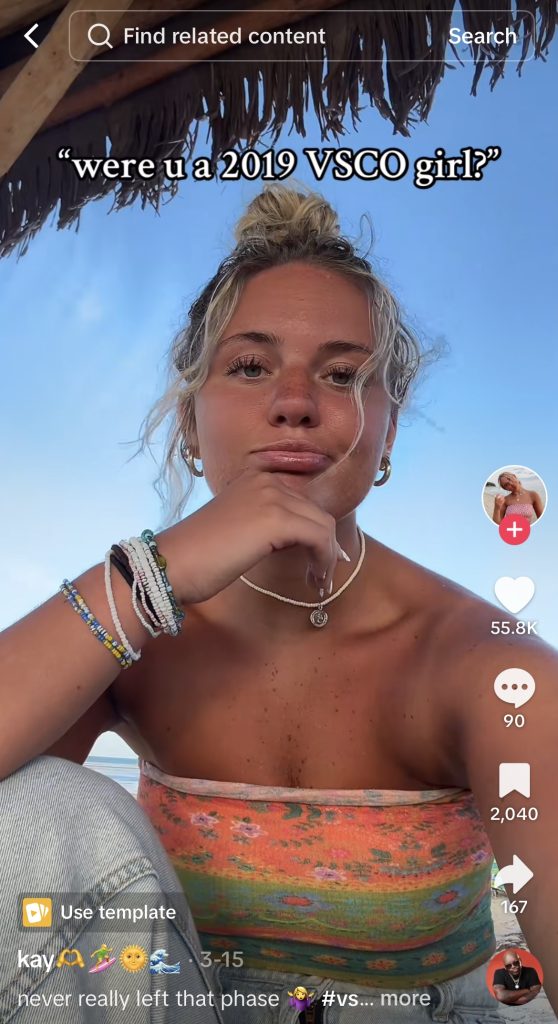
Granados: 'TikTok shifts the visual dialogue away from the perfectly manicured aesthetic of Instagram, which is known more for its users’ aspirational, flawless image curation. TikTok instead privileges on-screen presence, performance, and bite-sized narrative'. It can be messy and ambivalent, but those qualities make some TikToks inherently more complex than content on other platforms.
The rise of earnest work-from-home videos on TikTok from the onset of the pandemic and the subsequent increase in critique towards influencer culture, followed by the phenomenon of 'easy jobs' and a stronger conviction to build identity outside of work all facilitate a space for watery office sirens to star in the kind of content they created this summer.
Even if we crave authenticity in the things we encounter online, our platforms are built to give us just the opposite. They spike specific kinds of either vitriolic or banal content into virality and otherwise feed us images and clips that keep us on the platform without much meaningful action or real engagement. It’s like watching a puppet show and seeing all the strings: the magic is gone and the experience becomes distracting and jarring, odd and still somehow mesmerising.
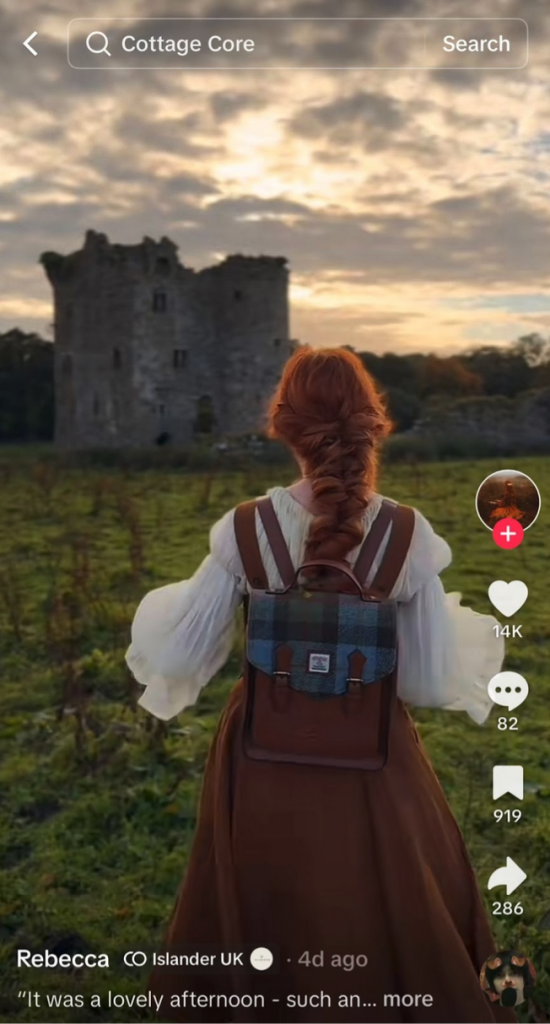
Every now and then, a new kind of sensibility emerges from TikTok that jerks me out of this state of passive agitated consumption (last year, it was corecore). Lin, Swart, and Seng contend: 'TikTok as a platform is not only mediating and facilitating the production of short videos but has become culture itself.' And culture produced by femme creators online continues to feed my curiosity and desire to bottle ideas into more cohesive forms, like this text.
As I wrap up, I keep close the notion that through TikTok and its endlessly personalised and mutating visual languages, a kind of transformation might occur. Experienced both by the creator and viewer – and perhaps the most interesting, in the blurry line between the two roles – this momentary shift creates an opportunity for a more conscious (self-conscious?) being online and offline. In this moment, we get a quick glimpse at the tethers that keep us moving like puppets, and as we look up, we see exactly who is holding up the strings.
References
Marlowe Granados, ‘I Turn My Camera On: Notes on the aesthetics of TikTok,’ The Baffler, no. 43, 2020.
Joshua Citarella, ‘Welcome to TikTok, the Wildly Popular Video App Where Gen-Z Make the Rules,’ Artsy.net, 2018, https://www.artsy.net/article/artsy-editorial-tiktok-wildly-popular-video-app-gen-rules.
Anne Gerlieb, ‘TikTok as a New Player in the Contemporary Arts Market: A Study with Special Consideration of Feminist Artists and a New Generation of Art Collectors,’ Arts, 10, 52, 2021.
Jian Lin, Joëlle Swart, Guohua Zeng, ‘Theorising TikTok cultures: Neuro-images in the era of short videos,’ Media, Culture & Society, vol. 45, 8, 2023.
Martina Leeker, 'Performing (the) digital: Positions of critique in digital culture,' Performing the Digital, 2016, eds. Martina Leeker, Immanuel Schipper, Timon Beyes.
About the Author
Agnieszka Wodzińska is a writer, art historian, and lecturer based in Scotland. She is interested in how environmental thought, notions of embodiment, and digitality manifest in popular and/or visual culture.

